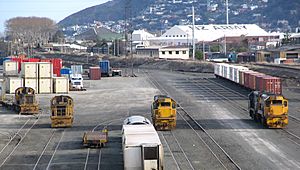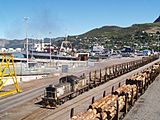Main South Line facts for kids
Quick facts for kids Main South Line |
|
|---|---|

Main South Line and shunting yards at Dunedin.
|
|
| Overview | |
| Status | Operational |
| Owner | KiwiRail |
| Locale | South Island, New Zealand |
| Termini | Lyttelton Invercargill |
| Service | |
| Type | KiwiRail rail freight |
| Operator(s) | KiwiRail |
| History | |
| Opened | 22 January 1879 |
| Technical | |
| Line length | 601.4 kilometres (373.7 mi) |
| Number of tracks | One |
| Character | Main Line (Lyttelton-Dunedin) Provincial (Dunedin – Invercargill) |
| Track gauge | 1,067 mm (3 ft 6 in) |
| Electrification | 14 Feb 1929 – 19 Sep 1970 (Lyttelton to Christchurch) |
The Main South Line is a very important railway line in New Zealand. It runs from Lyttelton in the north, through Christchurch and along the east coast of the South Island, all the way to Invercargill in the south. It also passes through Dunedin. This railway was one of the first to be built in New Zealand, starting in the 1860s. In Christchurch, it connects to the Main North Line, which goes up to Picton.
Contents
Building the Main South Line
Building the Main South Line happened in two main parts. The first part connected Christchurch to Dunedin. The second part linked Dunedin to Invercargill. This helped improve travel and communication in the southern parts of Otago and Southland. Work on the first section began in 1865. The entire line was finished on 22 January 1879.
From Christchurch to Dunedin
The Canterbury government built New Zealand's first public railway in 1863. It was called the Ferrymead Railway. People wanted a line south to connect with towns in South Canterbury, northern Otago, and Dunedin. So, in 1865, work began on what was then called the Canterbury Great South Railway.
At first, the Canterbury railways used a wider track size (1,600 mm (5 ft 3 in)) than what later became New Zealand's standard (1,067 mm (3 ft 6 in)). The first part of this line opened to Rolleston in 1866. Beyond Rolleston, builders thought about three possible paths:
- An inland route to cross rivers where they were narrower.
- A coastal line through rich farming areas.
- A middle path that was more direct and crossed rivers in good spots.
They chose the middle path. The line was built across parts of the Canterbury Plains towards Rakaia. By 1867, the line reached Selwyn, but the government ran out of money. Building stopped for a while.
In 1870, a leader named Julius Vogel announced a big plan for public works. Finishing the line between Christchurch and Dunedin was a top priority. A new law made the 1,067 mm (3 ft 6 in) track size standard for the country. Canterbury was allowed to extend its wider track to Rakaia, which happened in 1873. Soon after, Canterbury decided to switch to the standard track size. The wider tracks were completely gone by 1876.
Building happened from both ends: south from Christchurch and north from Dunedin. They also built from ports like Timaru and Oamaru. Construction was fast in the 1870s. By 1876, Christchurch was linked to Timaru. A year later, in 1877, the line reached Oamaru in north Otago.
At the southern end, the Dunedin and Port Chalmers Railway opened in 1873. This was New Zealand's first 1,067 mm (3 ft 6 in) track. Most of this line became part of the Main South Line. Building north from Dunedin was hard because of a steep hillside. The line from Dunedin met the line coming south from Oamaru at Goodwood in 1878. This completed the route from Christchurch to Dunedin.
From Dunedin to Invercargill
The railway from Dunedin to Clutha was one of the first lines built under Vogel's big public works plan. It was the first major line built using the 1,067 mm (3 ft 6 in) track size.
Building was quick. The first 10 km south from Dunedin to Abbotsford opened in 1874. By 1875, the line reached Balclutha, a major town 84 km from Dunedin.
At the Invercargill end, building was also fast. The first 17 km to Woodlands opened in 1874. But the section to Gore took longer, finishing in 1875, because a hill at Edendale kept collapsing. In December 1875, the lines to Winton and Bluff were changed from a wider track size to the standard size in just two days.
The land between Dunedin and Invercargill was hilly, needing more earthworks. The full route from Dunedin to Invercargill was finished on 22 January 1879. An opening party was held in Invercargill.
Since the line from Dunedin to Christchurch was finished in 1878, a complete rail link was now open all the way from Invercargill to Christchurch. This finished the Main South Line.
How the Line Operates
Passenger Trains
For many years, the passenger train service from Christchurch to Dunedin was the most important railway service in New Zealand. The first "express" train ran on 6 September 1878. It left Christchurch at 6 am and arrived in Dunedin at 6:40 pm.
When trains started running between Christchurch and Invercargill in one day (1904), the main passenger services to Invercargill were just an extension of the Christchurch-Dunedin trains. When the line was new, trains took 11 hours to go from Christchurch to Dunedin. They were usually pulled by steam engines.
Newer steam engines, like the A class (from 1906) and the AB class (from 1915), helped trains go faster. They could complete the trip in about eight hours.
The J class and JA class steam engines were introduced in 1939 and 1946. They were the last big steam engines used for passengers. They pulled the "South Island Limited" express train from Christchurch to Dunedin in just 7 hours and 9 minutes. These steam trains were famous for their speed on a section of track near Rakaia, nicknamed the "racetrack."
On 1 December 1970, DJ class diesel-electric locomotives took over from steam engines. This new train was called the "Southerner". Steam engines still ran some Friday and Sunday night express trains. These were the very last regular steam passenger trains in New Zealand. This is unusual because in most countries, steam engines finished their days on small, less important lines. In New Zealand, they ended on important express trains. This was because the train carriages used steam for heating. So, on 26 October 1971, a train from Christchurch to Invercargill became the last regular service pulled by a steam locomotive in New Zealand.
The Southerner train was even faster than the "South Island Limited." The trip between Christchurch and Dunedin was cut to 6 hours and 14 minutes. Later, it was even faster, at 5 hours and 55 minutes. This was partly because the Southerner did not carry mail, which had slowed down the older trains.
In the past, many local passenger trains and "mixed trains" (carrying both passengers and freight) used the Main South Line to reach smaller branch lines. But these trains were gradually stopped during the 20th century. An evening railcar service ran in the middle of the 20th century, taking 6 hours 10 minutes between Christchurch and Dunedin. It was cancelled in 1976.
The Main South Line was also used for local commuter services in Dunedin. These went north to Port Chalmers and south to Mosgiel. These local services ended in 1979 (Port Chalmers) and 1982 (Mosgiel). Between 1908 and 1914, the line to Mosgiel had two tracks because of all the commuter traffic. But it has since been changed back to a single track.
On 10 February 2002, the Southerner train was stopped because it was no longer making enough money. Today, only a few passenger services use small parts of the Main South Line. The TranzAlpine train uses the line between Christchurch and Rolleston before heading to Greymouth. Also, Dunedin Railway Station is used by trains from Dunedin Railways, though these services were stopped in May 2020.
Freight Trains
Before the 1960s, trains didn't focus much on carrying goods long distances between big cities. Instead, the Main South Line was used to connect to its many branch lines. Most freight trains were local, moving goods between regional areas and major ports in Christchurch (Lyttelton), Timaru, Oamaru, Dunedin (Port Chalmers), and Invercargill (Bluff).
For example, on the Dunedin-Invercargill part of the line, five branch lines north of Clinton mostly sent goods to and from Dunedin/Port Chalmers. Four branch lines south of Clinton mostly sent goods to and from Invercargill/Bluff.
As this short-distance local traffic decreased in the 1950s and 1960s, and branch lines closed, long-distance freight became more important. Trains started carrying goods directly between the major cities. The growth of container shipping also encouraged long-distance freight. The first freight train from Christchurch to Invercargill began in December 1970, taking 16 hours.
Today, to meet the needs of modern businesses and to compete with road transport, railway operations are always improving. A lot of traffic comes from large customers moving bulk goods. Even though passenger services are mostly gone, the future of long-distance freight on the Main South Line seems secure. It is a very important part of New Zealand's transport system.
Other Railway Lines Connected
Many other railway lines used to connect to the Main South Line. Below is a list of these lines. Most of them are now closed, unless noted.
- Bluff Branch (open for freight)
- Catlins River Branch (a small part is still open for industry)
- Dunback and Makareao Branches
- Fairlie Branch
- Fernhill Branch
- Kaitangata Line
- Kingston Branch (a part is open for freight as the Wairio Branch)
- Kurow Branch
- Methven Branch
- Midland Line (Rolleston to Greymouth, open for both freight and passengers)
- Moeraki Branch
- Mount Somers Branch
- Ngapara and Tokarahi Branches
- Ocean Beach Branch
- Otago Central Railway (the first 64 kilometres are still open for passengers; the first four kilometres are for industry, and the rest is owned by Dunedin Railways)
- Outram Branch
- Port Chalmers Branch (open for freight)
- Roxburgh Branch
- Shag Point Branch
- Southbridge Branch (a part is still open for freight as the Hornby Industrial Line)
- Tapanui Branch
- Tokanui Branch
- Waikaka Branch
- Waimate Branch
- Waimea Plains Railway
- Walton Park Branch
- Wyndham Branch


